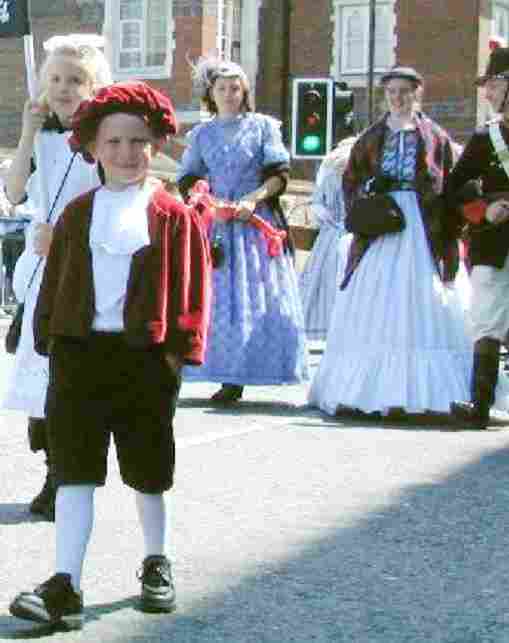
Historical Re-enaction: Early 19th Century

Figure 1.--This boy was outfitted for an English Dicksonian festival, but not very accuately. During the early 19th century boys wore mostly long pants. This boy is dressed more for a 18th century role than a Dickensian era festival--except for his cap. Note the girl behind him wearing a pinafore. The shoes of course are also wrong, but that is more understandable because of the cost.
|
Historical reinaction is popular in Europe as it is in Amerrica. Many cities have parades and processions dating back centuries. One particularly popular era in England is the Dickensian era. Reinactments of the early Victorian or Dickensian era are very popular. I'm not sure how popular this era is on the Continent, but there seems to be less interest in other countries. It is little observed in America--except in conection with Mark Twain festivals, Mark Twain and Huckleberry Finn. The outfits worn by American boys fpr these evens are much simplier and more utiliarian than the English Dicksenian events. The interest in this era is no doubt because of the continuing popularity of Charles Dickens' novels and the wonderful characters he created. HBC has noted, however, many inacuracies in the costumes prepared for the boys participating.
Garments
The boys pictured here have imaginative caps. They do not look like the kind of caps that were commonly worn by boys, but admitedly our information is limited at this time.
Caps
HBC is less sure of caps worn by boys. The tri-corner hat worn in the 18th century was little seen after the turn of the 19th century. Some boys wore military-style caps with a leather peak or bill. Tams were worn in the 19th centuy, but HBC is less sure about the time line for the type of tam worn by the boy in figure 1.
Skeleton suits
Many of these events are elaborately costumed. The most common boys' outfit for this era is the skeleton suit. Early skeleton suit styles were worn with knee breeches in the 18th century. By the turn of the 19th century, certainly by the 1830s-40s Dickensian era, all boys wore skeleton suits with long pants. In fact kneepants and knickers were rarely seen during this era. Boys mostly wore long pants. Interstingly, some mother think that historical dress for boys always requires shortened pants. Thus some Dickensian costumes are made with shortened pants--either kneepants or knickers.
Blouse
The boy here wears a white back-buttoning blouse with a jabot. Again this looks more like a 18th cebntury than a 19th century style.
Kneepants
Boys are often dome up in kneepants or knickers for these recreations. In fact, most boys at the time wore long trousers. It was boys who in fact forst introduced long trousers to polite society. Knicker-like pants had begin to appear in the 1930s, but long trousers were much more common until the 1870s.

Figure 2.--This boy was outfitted for an English Dicksonian festival, but not very accuately. During the early 19th century boys wore mostly long pants. This boy is dressed more for a 18th century role than a Dickensian era festival--except for his cap. Note the girl behind him wearing a pinafore. The shoes of course are also wrong, but that is more understandable because of the cost.
|
Hosiery
The boys here wear white stockings. HBC does not believe that white stockings were very common, although white socks were worn with long trousers.
Shoes
Historic re-enactors can perhaps be excussed if there are inaccuracies in footwear. Mums can often produce clothing of some historical accuracy without too great an expense. Historically accurate footwear, however, are not sometyhing a mum can piece together. Buying such footwerar could prove quite expensive.
Comments
One HBC contibutor commoents. "Anyone is vaguely Victorian dress is free to join the parade and many families make their own costumes. This looks like a home-made effort to me."
Another HBC contributor comnmenrs, "I am always impressed by how you catch these errors for re-enactors. I believe that some re-enactors are very careful, but most small boys do not care about the accuarcy and at festivals who is going to hurt a young child's feelings by excluding him because his costume is inacurate." Indeed HBC is not criticizing the boy. Interestingly younger boys like girls love to dress up in costmes, but they become very self-consious by 6 or 7 years of age.
HBC does not critcize boys in incorrect costuming. Their interest in history should be incouraged. Mun should, however, take a little more care. HBC notes that many mothers make no effort to look into proper costuming and just assume in earlier periods that boys wore knee pants. In fact from about 1790-1820, boys from affluent families were more likely to wear long pants than their fathetrs.
Christopher Wagner

Navigate the Boys' Historical Clothing Web Site:
[Return to the Main re-enaction page]
[Introduction]
[Activities]
[Bibliographies]
[Biographies]
[Chronology]
[Clothing styles]
[Countries]
[Essays]
[Boys' Clothing Home]
Created: June 2, 2000
Last updated: June 4, 2001




